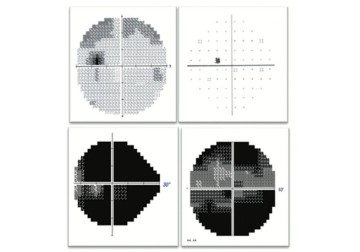In a new case report, Dr Sirisha Senthil, VST Centre for Glaucoma Care, Drs Deepika Parameswarappa and Jeyapoorani Balasubramannian from LVPEI discuss their choice of vitrectomy to treat refractory angle closure glaucoma in a patient with X-lined juvenile retinoschisis. They note the success of their approach which controls IOP, deepens the anterior chamber, and prevents a serious postoperative complication called 'Malignant Glaucoma'.
In many cultures, small groups of individuals observe geographic or cultural isolation from the larger setting they are a part of. These isolated groups are susceptible to developing rare, and sometimes pathogenic, ‘founder’ mutations. These mutations can pass to each new generation causing severe disease phenotypes. X-linked juvenile retinoschisis (XLRS) is one such rare, congenital, inherited retinal condition caused by a defective RS1 gene. The RS1 gene is found on the X chromosome and expresses the retinoschisin protein, which binds retinal layers together. A defective gene with a pathogenic mutation leads to ‘schisis,’ or clefts on the retina, and a corresponding loss of vision.
XLRS is a recessive condition and only affects men, with a known prevalence of 1 in 5000-25,000 people. This is because men have only a single X chromosome, and such a defect cannot be replaced with another copy (as men have a Y chromosome as the diploid pair). The RS1 gene has 6 exons (exons are the sequences on a gene that encode the protein), and there are several ‘missense’ mutations, where a single base pair is substituted—Base ‘G’ is replaced by ‘A’ for example—producing a different amino acid. Every person with these mutations will show symptoms of XLRS, though the intensity varies. XLRS leads to all sorts of vitreoretinal issues impacting vision and leading to sight loss. In very rare circumstances, it can lead to angle closure glaucoma where the drainage angle in the eye gets obstructed, leading to increasing intraocular pressure and optic nerve damage.
A new case report in Ophthalmic Genetics by Dr Sirisha Senthil and colleagues presents the treatment protocol for an XLRS patient with ‘refractory,’ that is hard to treat, angle closure glaucoma. The case has several interesting aspects: the rarity of the mutation, the long-term follow-up of the patient that notes the natural history of the condition and its progression, and a different surgical approach that not only helped in treating the condition successfully but also in preventing serious postoperative complications. Such complications are expected in these eyes requiring multiple surgeries and may also lead to the loss of vision. Indeed, a unique aspect of the paper is the case history of the patient over 20 years, recording the gradual loss of visual function over time despite medical and laser treatment to reduce IOP pressure. The case also includes molecular genetic testing of the patient, identifying the mutation at a single base on the patient’s RS1 gene.
The case notes that the standard protocol--glaucoma surgery of uncontrolled pressure—can lead to 'malignant glaucoma' as a complication after surgery, which is a very tough complication to manage. In this report, the authors discuss an alternative surgical approach of specialised vitrectomy with a modification to control the intraocular pressure that could be combined with cataract extraction. The XLRS patient featured in this report needed this intervention in both his eyes. With this modified treatment, they managed to achieve controlled pressures and glaucoma stability, and most importantly, prevented serious complications. They note that this new treatment protocol is a ‘paradigm shift’ in the management of such severe angle closure glaucomas associated with XLRS.
‘Appropriate clinical diagnosis, a multidisciplinary approach, and genetic evaluation to confirm the diagnosis of such a complex condition is particularly important, says Dr Sirisha Senthil, Head of the VST Centre for Glaucoma Care, and the lead author of this paper. ‘Also, learning from previous problems and innovating newer treatment options goes a long way in providing better and safer care for our patients.’
Citation
Sirisha Senthil, Deepika C Parameswarappa & Jeyapoorani Balasubramannian (2023) A paradigm shift in the treatment of refractory angle closure glaucoma in a patient with X-linked juvenile retinoschisis, Ophthalmic Genetics, DOI: 10.1080/13816810.2023.2188225
Photo credit: Fig. 4, RE showed paracentral scotoma and LE showed advanced field loss with central island of vision; Senthil et al.



